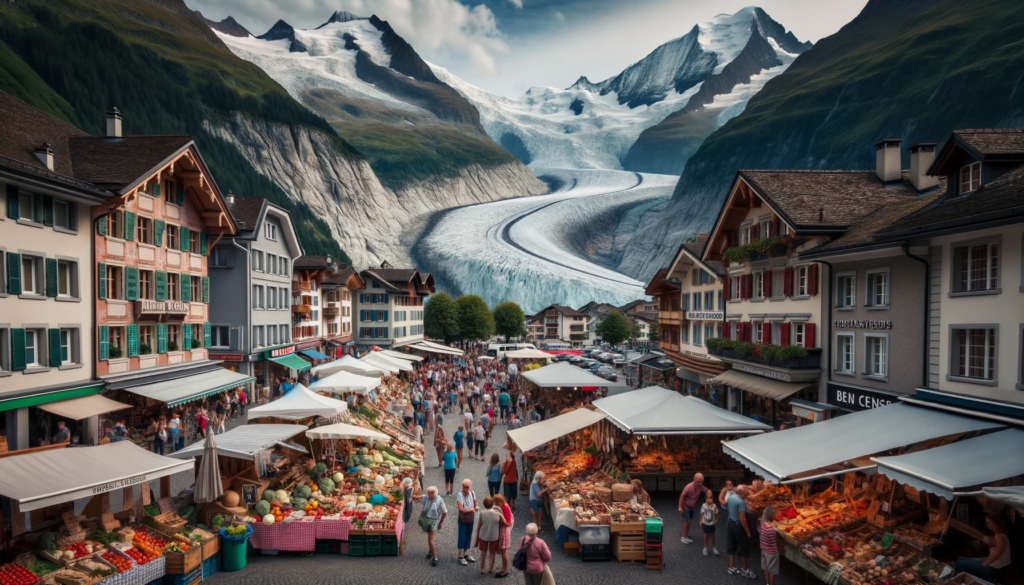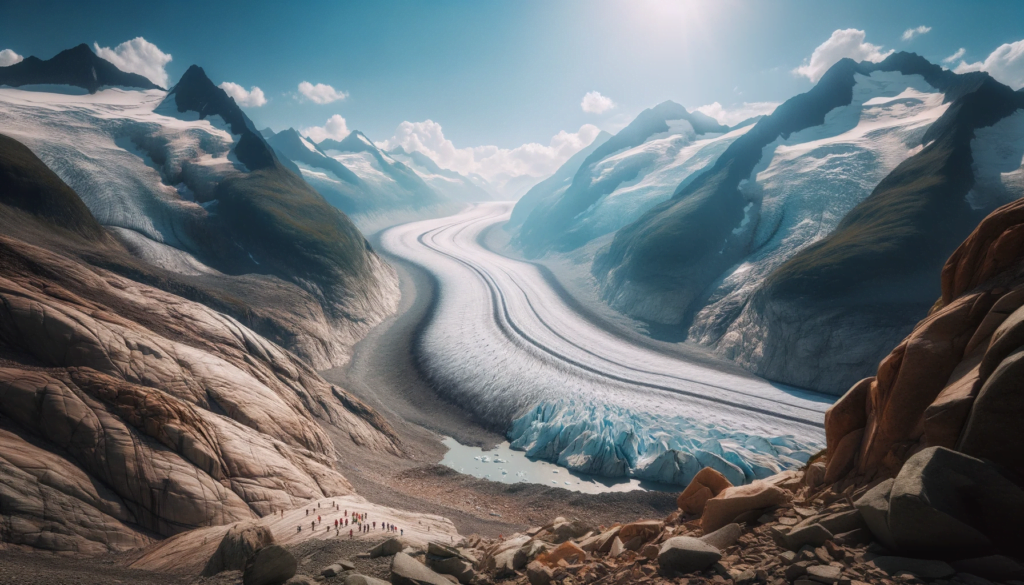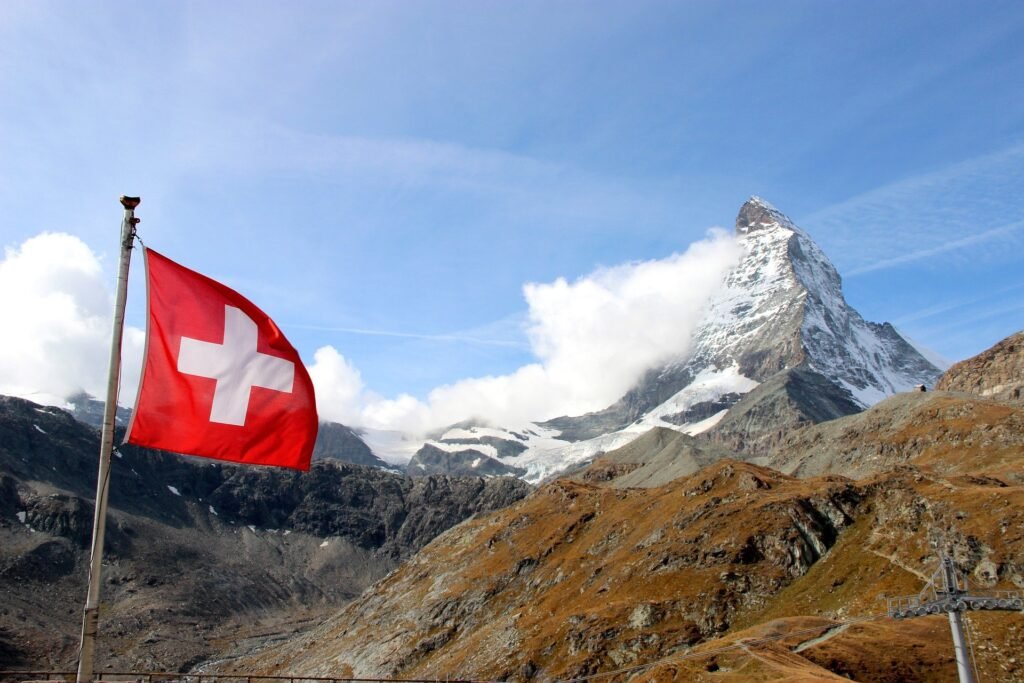Table of Contents
Introduction
Buy This Premium Website for Only $899 !
Acquire a high-authority website complete with content and a premium domain name.
Contact Us Today: Email: info@cleardesign.ch
Welcome to the captivating world of Aletsch Glacier, a mesmerizing natural wonder nestled in the heart of Switzerland. In this article, we will delve into the awe-inspiring beauty of the Aletsch Glacier, its significance as a UNESCO World Heritage Site, and the unique experiences it offers to visitors from around the globe. Join us as we embark on a virtual journey to explore the grandeur of this majestic glacier.
The Splendor of Aletsch Glacier: An Alpine Jewel
Nature’s Majestic Canvas
Spanning an impressive 23 kilometers, the Aletsch Glacier holds the title as the crown jewel of the European Alps. Its vast expanse presents a sight that is both humbling and awe-inspiring. Nestled in the heart of the Jungfrau-Aletsch-Bietschhorn region, the glacier is a marvel of shimmering ice, craggy peaks, and untouched alpine landscapes. Every crevice, serac, and moraine tells a story, offering a glimpse into the Earth’s dynamic processes. Visitors, from seasoned mountaineers to casual travelers, find themselves entranced by its grandeur. The glacier’s beauty is not just in its size, but in the intricate details carved by time and the elements.
A Globally Recognized Treasure
In 2001, the Aletsch Glacier received a distinguished honor, being designated as a UNESCO World Heritage Site. This recognition wasn’t just for its breathtaking visuals but also emphasized its ecological, cultural, and geological importance. As a World Heritage Site, the glacier draws attention to the need for conservation, not just of the ice but of the unique ecosystem and rich history surrounding it. This prestigious status brings with it a responsibility, shared by both local authorities and global entities, to ensure the glacier’s preservation. Tourists visiting can’t help but feel a sense of reverence, knowing they’re witnessing a site of exceptional universal value.
Traversing Geological Epochs
Diving into the annals of geological history, the Aletsch Glacier is a relic from the Earth’s past ice ages. Its formation, shaped by millennia of snow accumulation and ice flow, provides a window into the planet’s climatic evolution. But the glacier isn’t just about the past; it’s a living, moving entity, constantly changing and influencing its surroundings. The glacier’s journey has seen it carve valleys, feed rivers, and influence local weather patterns. Geologists and researchers find it a treasure trove of information, offering insights into climate change, geological processes, and even predictions for the future. For those who walk its trails, it’s like stepping back in time, experiencing the Earth’s ancient rhythms firsthand.
The Birth of the Glacier
The Aletsch Glacier’s story is a testament to nature’s grand designs and the relentless march of time. Born from countless snowflakes, each layer represents a year, a decade, a century. Over thousands of years, snow accumulation, compression, and the natural push and pull of gravity have worked in concert to shape this icy behemoth. But it’s not just the age that captivates scientists and tourists alike; it’s the record the glacier holds within. Each crevasse, layer, and icy expanse contains clues about past climates, atmospheric compositions, and even volcanic eruptions. To stand beside the glacier is to stand beside a living museum, a chronicle of Earth’s climatic history, preserved in frozen form.
Addressing Climatic Challenges and Preservation Endeavors
In our rapidly changing world, the Aletsch Glacier stands as a sentinel, highlighting the stark realities of global climate change. As temperatures rise, its icy facade has shown signs of retreat, shrinking in both length and volume. This isn’t just a loss for Switzerland or for those who cherish natural beauty; it’s an alarming indicator of larger environmental shifts. Recognizing this, numerous conservation initiatives have been launched. Scientists, environmentalists, and local communities are collaborating to study, protect, and raise awareness about the glacier’s significance. Efforts range from sustainable tourism practices to educational programs, ensuring that the Aletsch Glacier continues to inspire and educate for generations to come.
Adventures Amidst the Aletsch
For the intrepid explorer, the Aletsch Glacier is a playground of endless possibilities. Beyond its visual splendor, it offers a range of activities that immerse visitors in its icy embrace. Trekkers find solace in its winding trails, each offering a unique vantage point of the glacier and the surrounding Alps. Those seeking a more adrenaline-fueled experience might opt for ice climbing, facing the glacier’s walls head-on. And for those who prefer a more leisurely pace, guided tours provide a wealth of knowledge, unraveling the glacier’s many secrets. Each journey, whether on foot, with ropes, or through a guide’s narrative, deepens the connection between the traveler and this magnificent slice of nature.
Alpine Flora and Fauna: Nature’s Bounty
The region surrounding the Aletsch Glacier is more than just ice and snow; it’s a thriving ecosystem rich in biodiversity. As you ascend the heights or tread along the trails, you’ll encounter a variety of plant and animal species that have adapted to the Alpine conditions. Vibrant alpine flowers break through the rocky terrain, painting the landscape in hues of pink, yellow, and blue. Birdwatchers can spot eagles soaring overhead, while the keen-eyed might catch a glimpse of the elusive marmot or ibex. This harmonious blend of flora and fauna is a testament to nature’s resilience and adaptability, even in the harshest of conditions.
Sustainable Tourism: Traveling with a Conscience
The influx of tourists to the Aletsch Glacier brings both opportunities and challenges. While tourism boosts the local economy and spreads awareness about the glacier’s significance, it’s crucial to ensure that this footfall doesn’t harm the delicate ecosystem. Sustainable tourism initiatives have been at the forefront, promoting practices that minimize environmental impact and foster a respect for nature. From eco-friendly accommodations to waste management protocols, every effort counts in preserving the glacier for future generations.
Table: Key Highlights of the Aletsch Glacier Region
| Feature | Description |
|---|---|
| Length of Glacier | Approximately 23 kilometers |
| UNESCO Designation | World Heritage Site since 2001 |
| Popular Activities | Hiking, Ice Climbing, Guided Tours |
| Unique Flora | Alpine roses, Edelweiss, Gentians |
| Fauna Sightings | Golden eagles, Marmots, Ibex |
| Conservation Efforts | Sustainable tourism practices, Educational programs, Collaboration between scientists and local communities |
A Journey’s End and a New Beginning
As we conclude our exploration of the Aletsch Glacier, it’s essential to reflect on the broader implications of what this natural wonder represents. The glacier is not just an attraction; it’s a symbol of Earth’s fragile beauty and the urgent need for conservation. Every visitor, by choosing to travel responsibly, can play a part in ensuring that such wonders persist for centuries to come. As you depart from the Aletsch region, carry with you not just memories of its icy facades and alpine meadows, but also a renewed commitment to safeguarding our planet’s natural treasures.
The Cultural Connection: Beyond Nature’s Canvas
Nestled amidst the towering peaks and expansive ice of the Aletsch Glacier lies a tapestry of human stories and cultural significance. For centuries, local communities have lived in harmony with this icy behemoth, developing traditions, folklore, and practices shaped by the glacier’s presence. Festivals celebrate the changing seasons, while local tales often speak of the spirits and legends associated with the Aletsch and its surrounding mountains. This deep-rooted cultural connection underscores the fact that the glacier is not just a geographical wonder but also a cornerstone of regional identity.
Science and Research: Deciphering the Glacier’s Tales
The Aletsch Glacier is not just a destination for tourists and nature enthusiasts; it’s also a hub for scientific research. Glaciologists from around the world converge here, drawn by the unique opportunity to study a glacier of this magnitude up close. By analyzing ice cores, tracking movement, and monitoring meltwater, researchers gain invaluable insights into climate patterns, geological history, and environmental changes. The data gathered here often contributes to global studies on climate change, offering a microcosm of the larger transformations our planet is undergoing.
The Economic Pulse: Livelihoods Intertwined with Ice

For the towns and villages dotting the Aletsch region, the glacier is more than a stunning backdrop—it’s an economic lifeline. Tourism, driven by the allure of the glacier, fuels local businesses, from quaint bed and breakfasts to specialized tour operators. Additionally, the meltwater from the glacier irrigates fields and pastures, supporting agriculture and cattle farming. While the glacier’s retreat poses environmental concerns, it also has profound implications for the local economy, underscoring the intricate balance between man, nature, and commerce.
Final Thoughts: A Legacy to Cherish
In its silent majesty, the Aletsch Glacier tells a story that spans millennia. It’s a narrative of nature’s grandeur, human resilience, and the inexorable march of time. As the challenges of the modern world—climate change, urbanization, and shifting economic landscapes—converge on this icy expanse, the Aletsch stands as a reminder of what we stand to lose. It beckons us to pause, reflect, and act, ensuring that future generations inherit a world as wondrous as the one we know today. In the dance of ice and time, may we all find our rhythm and purpose.


